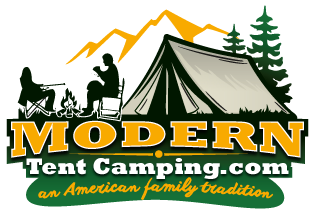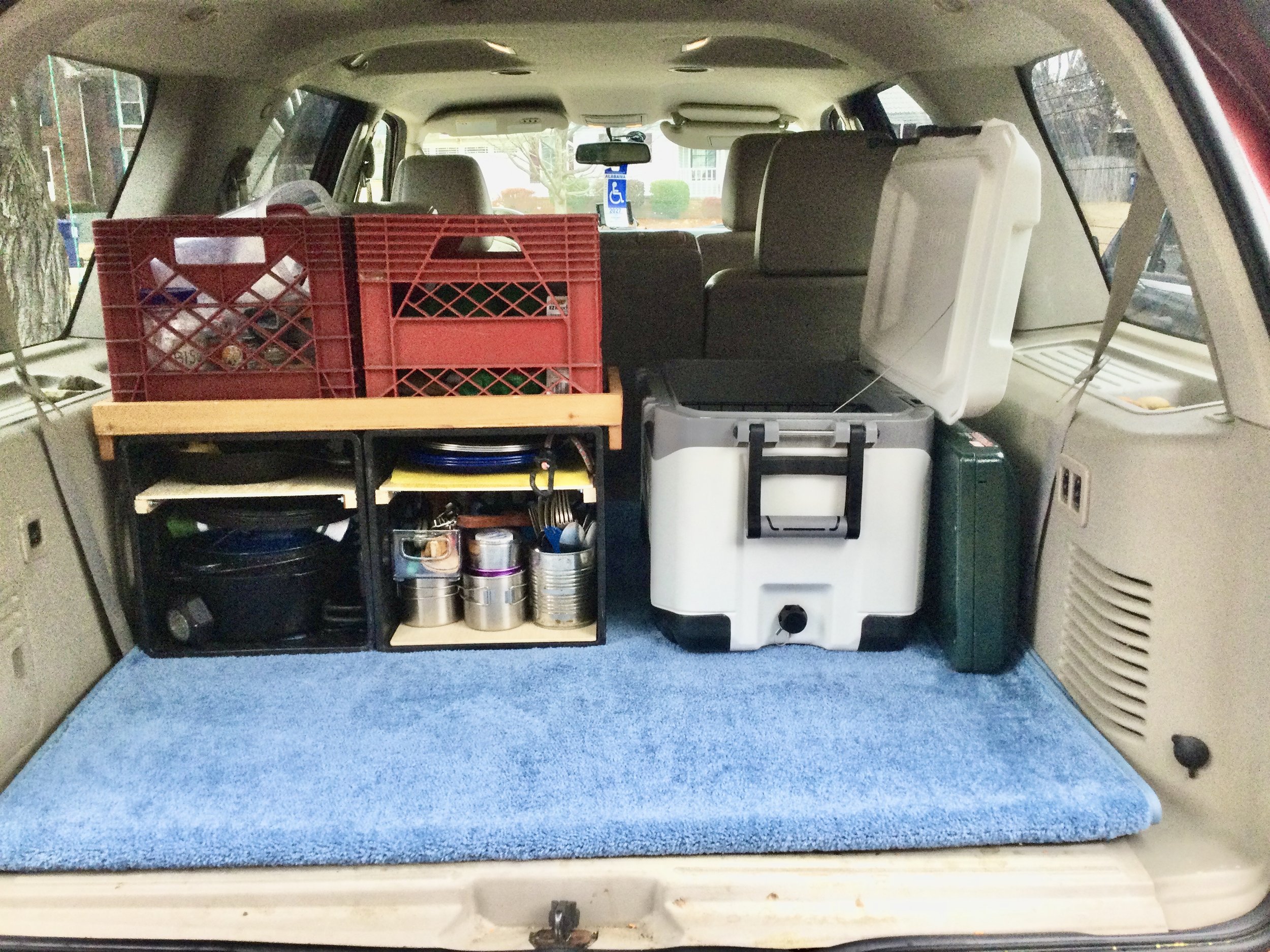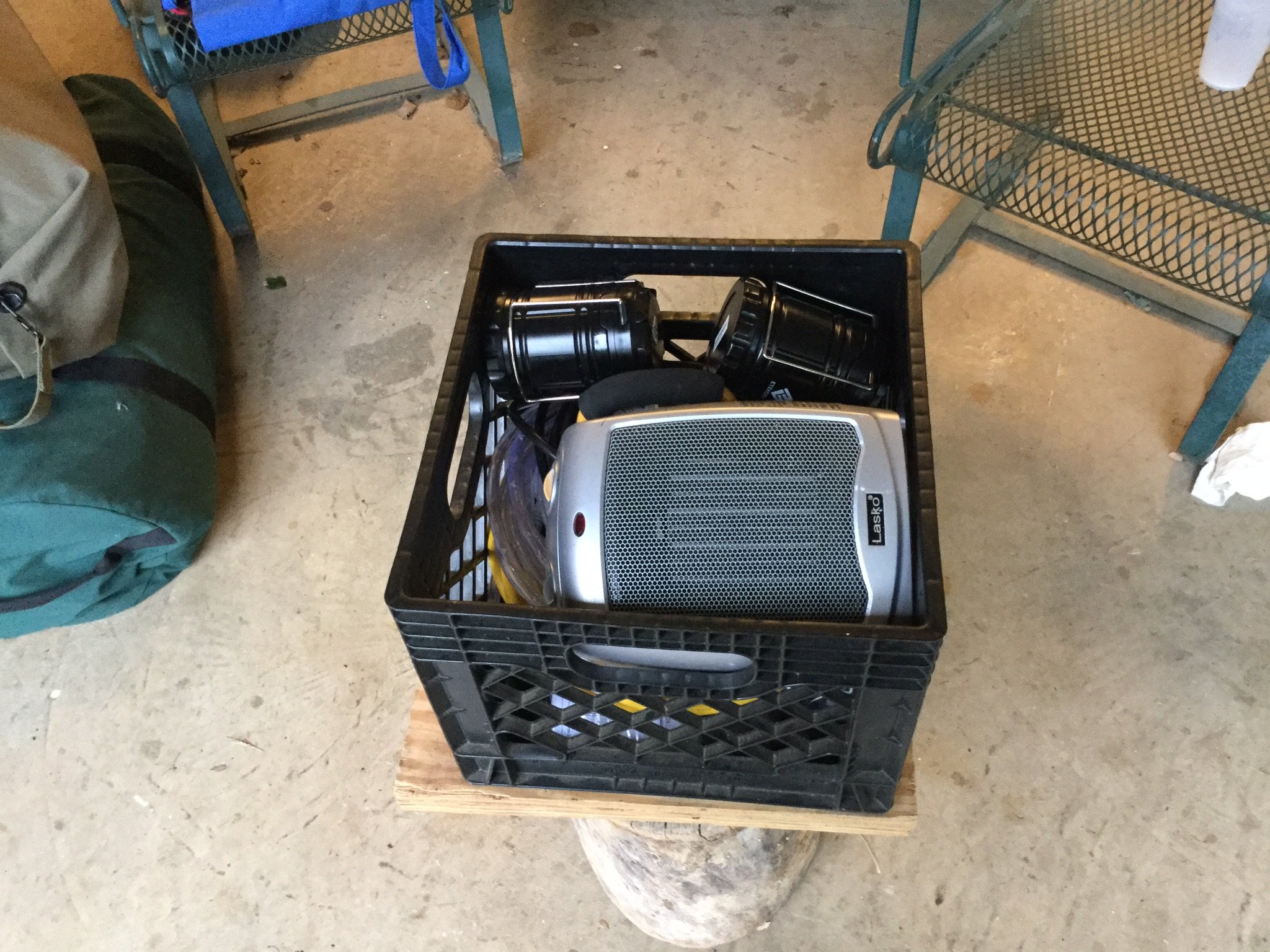Make a Checklist with Essential and Optional Gear
To remember important items for your camping trips, make a checklist or packing guide that organizes your camping equipment into logical categories with essential items, optional items, and helpful reminders in each category. Our checklist is presented below - organized by how we pack our car. For specific gear suggestions, check out other pages of this website - especially the CAMP STORE page.
Back Cargo Area of Car
Tableware, Utensils & Spices - pack in milk crate
ESSENTIALS: Plate, cup, bowl, water bottle & eating utensils for each person - plus a kitchen knife, tongs & can opener.
DESSIRABLES: Other cooking utensils (such as cheese grater and peeler) and extra tableware for more people.
Cookware - pack in milk crate
ESSENTIALS: Stainless steel or enamel steel cookpot.
DESIRABLES: Extra stainless steel or enamelware pots & cast iron or carbon steel frying pan. Select pots, pans, plates, bowls & cups that nest together.
OPTIONAL: Five quart Dutch oven & cake pan (to be used as a baking dish).
UNDESIRABLES: Avoid thin aluminum backpacker cook sets because they are only made to boil water and will quickly scorch your food if you try to cook anything for more than a few minutes.
Kitchen Supplies - pack in milk crate
ESSENTIALS: Paper towels, aluminum foil, fuel for stove, dish towels, garbage bags & food storage bags.
OPTIONAL: Table leg extenders.
Perishable Foods - pack in ice cooler
ESSENTIALS: Ice cooler. Buy a good-quality 50-quart cooler with a basket and drain but without wheels and a handle. This size is ideal for couples and families. It is large enough to hold food for several days but small enough to carry and pack in an SUV. If you don’t have space to pack a 50-quart cooler, pack one or two smaller 35-quart coolers.
DESIRABLES: Ground beef, bacon, summer sausage, other meats, eggs, butter, cheese, milk, meat, juice, mayonnaise, mustard, catsup, Italian salad dressing, jelly or honey & pancake syrup - all repackaged in small plastic containers with small items stored in waterproof plastic storage containers to prevent contamination from melted ice water.
UNDESIRABLES: Avoid coolers with wheels and handles because they require extra packing space and are unnecessary. Your food (cooler) should stay in your car at all times to avoid animal scavenger problems. Also, avoid all glass food containers.
Semi-Perishable Foods - pack in milk crate
ESSENTIALS: None
DESIRABLES: Bread, bakery items, onions, garlic, potatoes, peppers, carrots, lettuce, tomatoes, celery, corn, fresh fruit & fresh vegetables
Dry & Canned Foods - pack in milk crate
ESSENTIALS: None.
DESIRABLES: Sugar, peanut butter, rice dinners, macaroni & cheese, Hamburger Helper, pasta, McCormick's mixes, beans, pancake & biscuit flour, small cans of vegetables & fruit, canned chicken & tuna, cereal, crackers, peanuts, cookies, cereal bars, trail mix, chips, coffee, tea, hot chocolate & other drink mixes. Repackage beans, pasta, rice, grits, flour, and other dry goods in small or medium-sized plastic mayonnaise or peanut butter jars.
Stove & Fuel - pack fuel with kitchen supplies.
ESSENTIALS: Stove plus 2 or 3 butane lighters and propane fuel. Always pack a small stove and fuel, even if you plan to cook with a campfire or eat foods that do not require cooking. You may never use it, but a good backup stove is good to have in an emergency.
OPTIONALS: Fire starter bag, charcoal.
ATTENTION: Buy firewood from vendors near your destination. Do not move it more than 30 miles to your campsite. If campground does not sell good firewood, find a farm supply store, home improvement store, grocery store, or local firewood dealer.
Water Containers
ESSENTIAL: Personal water bottle for each person and larger 1 gallon container. Draw water from potable water spigots, and carry to your cooking and dish washing areas.
DESIRABLES: Two 1-gallon water jugs. Ocean Spray jugs and Gator-aid bottles are economical choices.
UNDESIRABLES: Avoid large 3 to 5-gallon containers because they are difficult to carry from the spigot to your campsite, difficult to move about your campsite, and difficult to pour.
UNNECESSARY: Water filtration and purification equipment.
Sleeping Tent - pack in large duffel bag on top of kitchen gear
ESSENTIAL: Most couples and small families that camp in developed state and federal campgrounds will need a good-quality 6-person tent with aluminum or strong fiberglass poles and approximately 90 square feet of floor space to provide adequate protection from rain, wind, mosquitoes, bugs, and dirt.
Kitchen Shelter - pack in a large duffel bag on top of kitchen gear
ESSENTIALS: None
DESIRABLE: Kitchen shelter, screen room, or tarps. A second shelter is desirable to protect you from bright sunshine, hot mid-day sun heat, wind, dew fall, and rain. Use this shelter to prepare meals, eat meals, repair equipment, play games, read books, and relax.
Folding Chairs & Tables - may have to tie on rooftop luggage rack
ESSENTIALS: None
DESIRABLES: Table cloth, folding chairs, four-foot folding table (2 is even better) & hammocks. Although most developed campgrounds furnish a picnic table in each campsite, these tables are large, awkward, difficult to move, and too low for prolonged food preparation. To maximize comfort and convenience, pack additional chairs and small tables. Make leg extensions to raise one table to 36” countertop height. Watch my TABLE LEG EXTENSIONS video for details.
Pack kitchen gear in back of car
Pack sleeping tent and kitchen shelter on top of kitchen gear
Back Seat Area
Lights & Electrical Gear - pack in milk crate
ESSENTIALS: A small headlight or flashlight for each person plus a spare and extra batteries. These lights will be needed for walking around after dark.
DESIRABLE: Pack several additional flashlights and lanterns for your campsite and night-time activities. You’ll need at least one light for your tent and another one or two for your kitchen shelter. If you stay in your campsite several nights, you’ll also need extra lights or batteries. When camping in the middle of the summer, the sun sets about 10 PM - so you won’t need many lights. But when camping in early spring and late fall, the sun sets about 6 PM - and you’ll need lots of lighting gear. Also pack outdoor extension cords to charge cell phones, cameras, and chargers for your electronics. Other desirable electronic gear include a thermometer and an adaptor for converting 50 amp plugs to 110v. Also Include a fan or heater depending on the weather.
UNDESIRABLE Avoid candle lanterns, gas lanterns, and other open flame light sources because they are messy to pack and create a fire hazzard if brought into the tent.
Bucket & Extension Cords
Use bucket for grey water during the day and as a toilet at night
Clothing - pack in duffel bags to be used as pillows
ESSENTIALS: Pack plenty of fast-drying warm clothes for cool nights and sleeping. Be sure to include nylon or polyester underwear, wool socks, polyester or wool short-sleeve T-shirt, polyester or wool long-sleeve T-shirt, polyester or fleece athletic pants, polyester or fleece hoodie, knit cap, hat or cap & rain coat.
DESIRABLES: Pack as many as 7 pair of socks and underwear to minimize time required for washing clothes.
UNDESIRABLES: Avoid cotton garments such as denim jeans, cotton sweat shirts, sweat pants, socks & underwear.
EXCEPTION: Light colored cotton T-shirt in hot weather.
Personal Items - pack in duffel bag or day pack
ESSENTIALS: Medicines, shower & hygiene items (soap, wash cloth, small micro-fiber towel, brush, tooth brush, toothpaste). Use the day pack to carry water, sun screen, first-aid supplies, and jackets on day hikes and to make a pillow at night.
DESIRABLES: Shower shoes, tooth paste, floss, brush, razor, nail clippers, tweezers, cotton swabs & scissors.
Bedding - pack in duffel bags
ESSENTIAL: An insulating layer (such as a wool blanket or carpet) under your mattress, a comfortable mattress, and warm clothing are the three most important pieces of camp bedding.
DESIRABLE: Use a standard fitted sheet to hold 2 mattresses together - or - a king-sized fitted sheet to hold 3 mattresses together. Use a synthetic or wool blanket or quilt for cover. Use a small duffel bag, day pack, or rolled blanket with a pillow case to make a pillow. In hot weather pack a fan and wear a cotton shirt soaked with water. The breeze blowing over the wet shirt will produce an air conditioning effect.
OPTIONAL: Pillows.
UNDESIRABLE: Avoid air beds because they frequently spring leaks after limited use. Avoid mummy sleeping bags unless you plan to camp in very cold weather. Avoid down-filled sleeping bags because they will not keep you warm when wet - and they WILL get wet, and because they require much longer drying time.
Tools - pack in heavy Cordura tool bag.
ESSENTIALS: You will need tools to efficiently set up camp, perform routine camp chores, make emergency repairs, and break camp at the end of your trip. Tent stakes, pocket knife (or multitool) & cord.
DESIRABLES: Camp axe, large camp knife, folding saw, wedge, baton, channel lock pliers, small crow bar, rake & small shovel. You can make a baton and wedge from small pieces of hickory firewood
Games & Toys
ESSENTIALS: None
OPTIONALS: Electronic items, hiking staff, book, deck of cards, dominoes, board games, tree/bird field guides, binoculars, water toys, sketch pad, radio, bean bag toss, fishing tackle, bikes, canoes, golf clubs, & other recreational equipment.
Pack lights, fan or hearer, and other electronics in a milk crate.
Pack a tool bag with basic tools needed to set up camp, perform routine camp chores, and break camp at the end of your trip.
Other Gear
Health Supplies - pack in small bag under front seat
ESSENTIALS: Assemble the supplies needed to prevent and treat common health problems and injuries - and keep these supplies in an accessible location inside your car. First-aid kit (adhesive bandages, Neosporin, burn cream, ibuprofen, aspirin, gause sponges, elastic bandage, rubber gloves), sun screen & insect repellant.
DESIRABLE: Assemble a second first-aid kit for your tent.
Navigation - place on car dash
Do not depend upon cell phone or GPS navigational devises. They may not work properly in remote areas. Always carry a good roadmap. Use GPS receiver or cell phone maps for helpful navigation tips.





